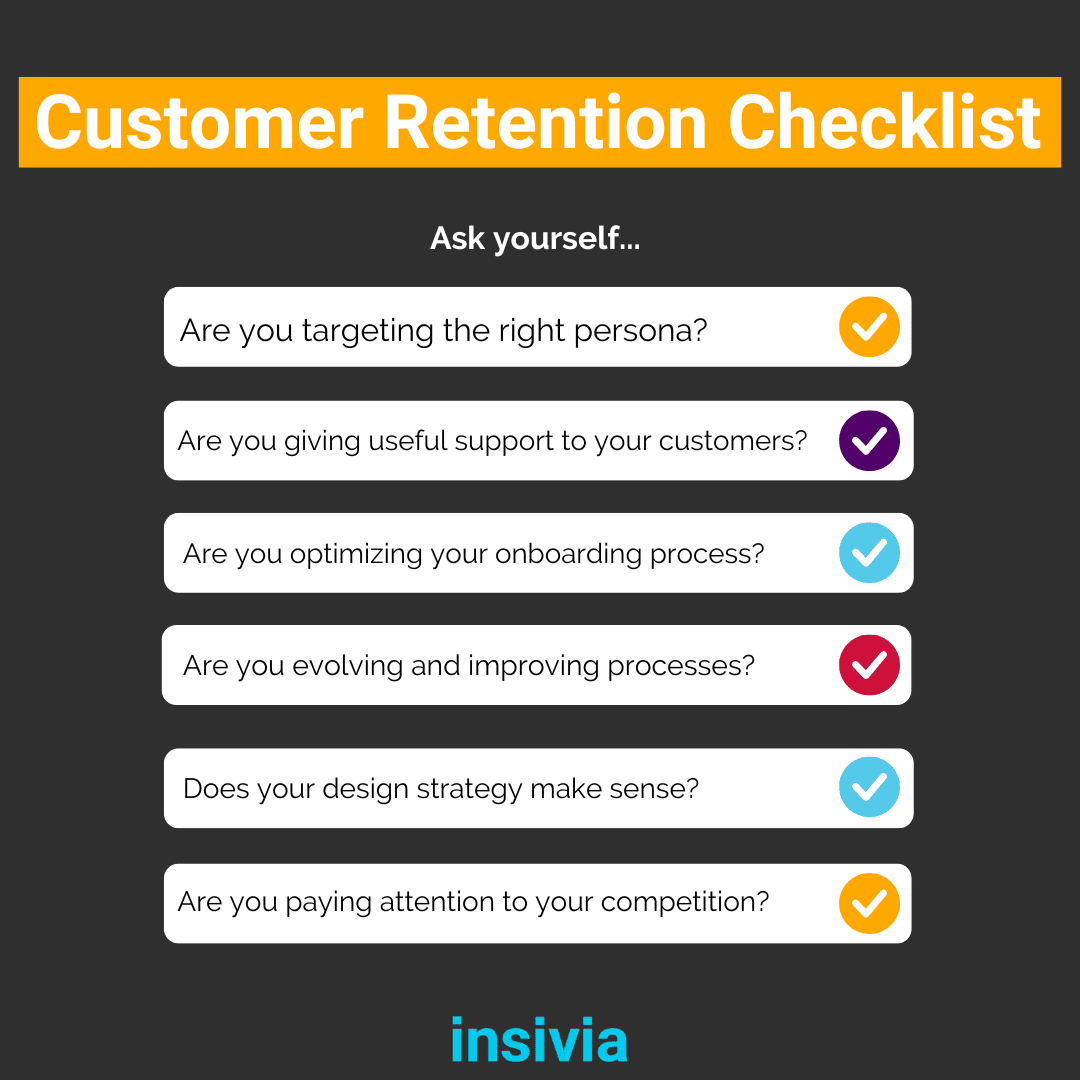Customers are the lifeblood of your company. Without them, you would not be able to survive. That’s why it is so important to keep retention high and churn low.
In fact, only 20% of SaaS founders focus on customer retention.
In today’s SaaS landscape, people want the best experience possible with companies and will go out of their way to find a company that caters to them the best. In fact, 50% of customers churn due to one bad experience according to ZenDesk’s Trends Report. Experience matters, and even if you have a cheaper offering or more robust features, customers will churn if the experience and promise are not what they’re looking for. This is why customer retention strategies are important.
There are ten often overlooked reasons why your customers may be churning. This article dives into how to keep retention rates high and prevent customers from leaving!
Reason 1: Targeting the Wrong Audience
TLDR: TARGET NICHE AUDIENCES WITH INTENTIONAL COMMUNICATION
A common obstacle that companies big and small face is ensuring they are reaching the right niche audience. Not reaching the target audience for your product, service, or platform increases the likelihood of customer churn solely because they are not a part of the market segment you wish to address.
Maybe you’re aiming for the wrong industry experts or even geographic regions. And, maybe your marketing message is not resonating with your audience.
Sometimes we tend to forget that B2B customer journeys are very similar to B2C. To put it simply, think about finding your target consumer. Who is out there that would benefit the most from your product? Use the answer to that question to aim your marketing efforts toward that persona(s). This will help you be most efficient with your time.
- Target Persona = niche person or group that would resonate directly with your product/service/messaging
- General Persona = “who should get this information?”
Reason 2: Providing Unclear Support
TLDR: COMMUNICATE & DISPLAY YOUR VALUE CONSTANTLY
Customer churn rate can increase because they cannot recognize the potential value of your product, or they simply receive no value from your product, service, or platform at all.
This could be because the product is not meeting their needs, or they do not understand how to use it properly.
It is imperative to effectively communicate your business’s worth to customers prior to initial discovery calls or conversations through a thorough knowledge center.
Creating a great customer experience requires you to stay connected with your clients. You are a support system for their business so you have to remain in the know of their needs and obstacles… sometimes before they even do.
Get personal, know their product and think of innovative ways to offer additional solutions.
You can even announce new features from time to time to grab their attention to a tool they may not be using but would deeply benefit from.
Make the customer feel valued, so they value you. #LTV
Reason 3: Customer Journey is Failing
TLDR: KEEP IT SIMPLE, EASY TO UNDERSTAND, AND DESIGNED WELL
It is essential to provide excellent communication and support at every stage of the customer journey.
An excellent experience is crucial to retaining customers for longer. It’s important to note that exceptional service, communication, support, etc. do not end at the onboarding process. You must ensure you keep your customers engaged with and excited about your product, service, or platform throughout their entire journey.
Your customer journey should be designed with the customer in mind.
It should be easy to understand and provide value at every stage. When your messaging feels genuine, personal, and direct, your potential customers will feel appreciated, increasing their customer lifetime value for your business. If your customer journey is confusing or difficult to use, customers will churn . You don’t want to leave them hanging!
A study shows that 91% of customers who have a poor experience with a company just up and leave without notice. And, 40% of them will go on to tell other potential buyers or clients not to utilize the company due to their own bad experiences.
Your customer success strategy must be developed strategically and intentionally. This means, tracking customer health scores and taking decisive action as needed. One example reported by Vitality.io showed a SaaS company that was able to reduce churn rates by 50% in just one year by “automating time-consuming tasks and increasing CSM bandwidth with customer insights.”
Reason 4: Letting Growth Idle
TLDR: CONSTANTLY ANSWER FAQs, PROVIDE SOLUTIONS, AND ENGAGE YOUR AUDIENCE.
Your SaaS product should be constantly evolving to meet the needs of your customers, otherwise, they’ll bounce and forget about you. Make sure you are consistently collecting feedback from your customers and using it to improve your product.
Your service is not the only thing that should be expanding.
Your company as a whole should be regularly growing.
If you are not keeping up with the latest trends, your customers will churn. They want to work with a company on the cutting edge, not one stuck in the past. Don’t remain stagnant.
This also applies to the moments when something goes wrong. It is vital to be proactive, not reactive . For example, if you know that a certain feature is causing problems for your customers, take steps to fix the problem before it becomes a bigger issue, otherwise, you’re giving customers reasons to churn.
If you fail to keep up with your customer’s needs, they will lose interest and confidence in your product. And, in turn, you lose the credibility and reliability every SaaS business requires for growth.
TLDR: DESIGN WITH CONSTANT FEEDBACK BASED ON USER INTERACTION
Reason 5: Implemented a Poor Design Strategy
Your SaaS platform or website should have a design strategy that is focused on the customer. The customer should be at the center of every decision you make. Strong user experience design will elevate your core messaging; most importantly, designing with the user in mind will ensure a lower bounce-rate.
Your user interface design strategy should be based on data, not assumptions. Use data to understand how your customers are using your product and what their needs are. This will help you make better design decisions that are focused on the customer. In fact, you can use cohort analysis or cookies to better understand your users’ behaviors.
If your product is not designed well, the user will be confused and frustrated, and they will happily find another solution.
Make sure your design is clear, simple, and focused on the customer.
Reason 6: Confusing Onboarding Process
TLDR: KEEP MESSAGING & INSTRUCTION CLEAR
The onboarding process is one of the most important factors in customer retention. If your onboarding process is confusing or difficult to use, chances are potential clients will leave and find a simpler platform.
The main goal for onboarding should be focused on helping the customer get a clear understanding of your product and the services you offer. Don’t overcomplicate things. Simplify your process the best way you can and you’ll begin to notice more people attracted to your product.
High retention software has a great dashboard that communicates how to navigate sticky features or content clearly.
Reason 7: Lack of Knowledge of Competition
TLDR: EDUCATE YOUR TEAMS (AND YOURSELF) ON WHAT TRENDS ARE A RISING IN YOUR INDUSTRY
If you are not aware of your competition, you will lose customers to them. You can bet that your competition is on your customers’ radars. Don’t let your competition give your customers reasons to churn from your product, service, or software.
Make sure you are constantly monitoring your competition and adjusting your product and pricing accordingly. This practice may also inspire you or your teams to ideate beyond your usual routine. By turning this into a habitual cycle, you might even find new opportunities to explore in regard to marketing efforts, sales processes, and service features.
Done properly, consistently creating competitive analyses will give your company and your retention strategies quantitative and qualitative data to back new decisions. In particular, it will help you validate your Unique Value Proposition and prioritize product development by focusing on aspects your competitors’ customers value the most. Lastly, you will improve your product by capitalizing on your competitors’ weaknesses that their customers criticize, leaving more room to provide a better overall experience. Try this basic template by Buffer if it’s your first time utilizing this strategy.
Competition is good, and it challenges your ideas and current processes. Don’t ignore the opportunity to learn and grow from the trends you’re noticing. Ideas may spark and you’ll discover new ways to stand out!
Reason 8: No Optimization Techniques
TLDR: CREATE PEOPLE-FIRST CONTENT WITH A USER-FRIENDLY INTERFACE
This could range from doing surveys, testing, or original research on what’s working and what’s not. If you’re not using optimization techniques, you will have a hard time understanding what your customers want and need. As a result, churned customers increase becasue you aren’t in tune with what needs must be met.
Don’t you hate it when a website won’t load correctly, or an app is taking forever to pull up? Research shows that when loading times increase from one to three seconds, the probability of a bounce increases by 32 percent.
You want to make sure your platform is easy to navigate and load. Without a user-friendly interface, you’ll lose customers pretty fast. By using optimization techniques, you can identify areas of improvement and make changes that will reduce friction in the customer experience.
Reason 9: Unfocused Strategy
TLDR: NARROW YOUR FUNNEL
The SaaS world is huge, and it can be tempting to try to appeal to everyone. However, this will only make it harder for you to convert leads into customers. It’s better to focus on a specific audience and narrow your funnels. This way you can create targeted content that appeals to your ideal customer.
It’s like the saying goes, “quality over quantity”. Don’t shoot randomly in the dark for prospects. You need to narrow down the audience you’re trying to reach in order for your business to keep your customer retention and build its reputation.
TLDR: EVALUATE YOUR PRICING MODEL CONSTANTLY WHILE REMAINING COMPETITIVE
Reason 10: Neglected Pricing
The pricing of your product has to emulate what you’re offering. If it’s too expensive based on what the customer is getting, then that’s obviously a bad sign. Keep your pricing competitive and reasonable. You can always increase your prices as you add more features, but make sure the customer feels like they’re getting their money’s worth. If you can’t explain why your product is priced the way it is, then you need to re-evaluate.
You should also offer different pricing options to appeal to a wider range of customers. For example, if you have a SaaS product that has a monthly subscription, offer a discount for those who sign up for a yearly subscription. Deals or discounts appeal to everyone. Maybe even try a tiered pricing model to accentuate the value of the features you’re offering. It’ll catch their eye and they’ll gain more interest. Who doesn’t like a good deal right?

The bottom line is this:

If you want to keep your customers, you need to provide value at every stage of the customer journey. It’s all about understanding the user and their needs. There are many other reasons why customers may churn, but these are some of the most common ones. If you can address these issues, you will be well on your way to reducing your churn rate.
Written by: Tony Zayas, Chief Revenue Officer
In my role as Chief Revenue Officer at Insivia, I am at the forefront of driving transformation and results for SaaS and technology companies. I lead strategic marketing and business development initiatives, helping businesses overcome plateaus and achieve significant growth. My journey has led me to collaborate with leading businesses and apply my knowledge to revolutionize industries.
